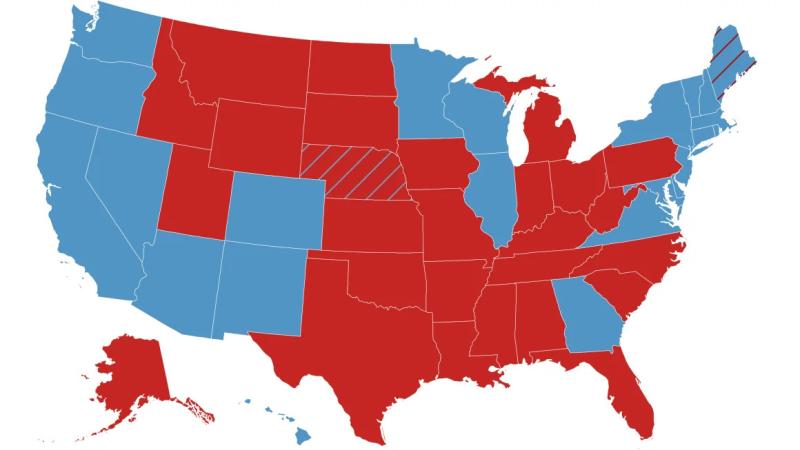What happens if there’s a tie in 2024? Be ready for a ‘contingent election’
By: Zachary B. Wolf, Ethan Cohen and Renee Rigdon (CNN)


Stock up on popcorn!

With two presidential candidates fighting over a mere 538 Electoral College votes, a tie scenario is more than possible. It’s actually kind of surprising there has only been one tied election so far, in 1800, between Thomas Jefferson and Aaron Burr.
That tie was the result of a failure of coordination by Democratic-Republicans, but it led to the nation’s first “contingent election,” decided in the House of Representatives.
Could a tie actually happen this year?
Yes. While a tie is not a likely outcome, it is something to be ready for. Here is one plausible scenario for the 2024 election:
If Vice President Kamala Harris , the presumptive Democratic nominee, wins Wisconsin, Michigan, Arizona and Nevada and a single electoral vote in Nebraska, all of which President Joe Biden won in 2020, but she loses Pennsylvania and Georgia, there’s a tie, 269-269.
The website 270 to Win also has more tied-election scenarios.
Three 269-269 maps
There are many ways a tie could play out in the Electoral College, but these are some scenarios:

Unlike every other state, Maine and Nebraska award two electors to the statewide winner and one to the winner of each congressional district. Those individual, competitive electoral votes in Maine and Nebraska become hugely consequential in potential tie scenarios.
Make your own 269-269 scenario with CNN’s interactive election map .
What happens if there’s a tie?
If there’s a 269-269 tie, or if a third party or independent candidate wins electoral votes and keeps a candidate from reaching an Electoral College majority of 270, the next step is the same. It’s called a “contingent election.”
According to the 12th Amendment , enacted in the wake of that divisive 1800 election, if no candidate gets a majority of the Electoral College votes, the new Congress, which would have just been sworn in on January 3, chooses the president. The Senate would choose the vice president.
When would a ‘contingent election’ occur?
According to an analysis by the Congressional Research Service , a contingent election would occur on January 6, immediately after members of Congress met to count electoral votes and determined that no candidate had a majority.
There is a lot of information from that CRS report in this story. While it dates back to 2017, it’s still a valuable resource.
How would the process work?
The nation would clearly be divided. Lawmakers could be torn between supporting their preferred candidate and the one their state’s voters preferred.
In a contingent election, the House selects the president and the Senate selects the vice president. House members can only choose from among the top three finishers in the Electoral College for president, and senators can choose from among the top two finishers for vice president.
Rather than voting as individuals, each state delegation in the House would get one vote, although how the state delegations select their preferred candidate is not spelled out. A simple majority, 26 state delegation votes, would appoint the new president.
If state delegations in the House did not select a president by Inauguration Day, January 20, the new vice president selected by the Senate would become temporary president. It is possible the Senate could select a vice president when the House is deadlocked, because in the Senate each senator would get one vote.
If the Senate had not selected a vice president by January 20, the presidential succession plan in the 20th Amendment temporarily takes effect. First in line after the vice president is the speaker of the House, currently Mike Johnson, although it could be a different Republican or a Democrat if Democrats win a majority in the House this November.
Does either side have an advantage?
If the Electoral College already benefits smaller and more rural states, the contingent election process – in which each state, regardless of population, has an equal vote – gives them a huge advantage.
California and Texas get the same say as Delaware and Wyoming in a contingent election. Plus, Washington, DC, which gets three votes in the Electoral College, would be cut out of the contingent election.
There’s nothing to require state delegations to honor the winner of their state’s vote. And in closely divided states, the results in single seats, perhaps determined by gerrymandered congressional maps, could swing a delegation’s vote.
Heading into the 2024 election, Republican lawmakers held a majority in 26 states, compared with Democrats, who held the majority in 22, with ties in Minnesota and North Carolina. Republicans in North Carolina have changed the state’s congressional map, however, and it is likely to have a majority-Republican congressional delegation in January. Republicans are likely to maintain their advantage next year, especially if voters are so split that they deliver a national tie at the top of the ticket.
In Arizona, for instance, who is to say that a potential majority of Republican members of Congress would vote for the Democratic candidate, even if Harris pulled out a narrow win there? Would Alaska’s Democratic member of Congress, assuming she wins reelection, vote for the Democrat for president even though her state is likely to go for Trump in November?
Why does this bizarre tie-break system exist?
It’s actually meant to be an improvement. The way the Electoral College was first assembled, electors voted for two candidates. Whoever got the most votes was president and whoever got the second-most votes was vice president.
By the time political parties were forming – Federalists and Democratic-Republicans in 1800 – electors needed to coordinate to cast more votes for their presidential pick than their vice presidential pick.
In the 1800 election , a rematch of 1796, Jefferson’s Democratic-Republicans beat incumbent President and Federalist John Adams.
But the Democratic-Republicans were poorly coordinated or bad at counting and foolishly cast equal numbers of votes for their presidential pick, Jefferson, and his running mate, Burr.
Out of pique, when the early version of the contingent election rolled around, the Federalists, who still controlled the House at that time, backed Burr. Despite the intervention of Alexander Hamilton, a noted Federalist, it took 36 rounds of voting to finally elect Jefferson.
By 1804, the 12th Amendment was being ratified.
Has a contingent election happened in the years since the tied election of 1800?
Yes. In 1824 , multiple candidates got votes in the Electoral College but none of them received a majority, triggering a contingent election.
Amazingly, from today’s perspective, all of the candidates who got Electoral College votes that year were from the same Democratic-Republican political party, although they were split into regional sects.
Andrew Jackson won 40% of the popular vote and got the most votes in the Electoral College with 99 of the 131 needed for victory. But the House ultimately picked his top rival, John Quincy Adams, whose father lost that 1800 election.
Jackson would have his revenge with a victory four years later, and John Quincy Adams would round out his career as the only former president to be elected to Congress, the body that made him president.
Another contingent election occurred with the 1836 race, but just for vice president. Virginia’s electors did not like Robert M. Johnson, the running mate of election winner Martin Van Buren, and withheld their votes for him in the Electoral College. The Senate later elevated Johnson to the vice presidency in a contingent election.
What about the disputed election of 1876?
In 1876, when there was a contested outcome, the contingent election system was bypassed.
That year, at the height of Reconstruction, the issue was not that no person got a majority in the Electoral College, but rather that three Southern states – Florida, Louisiana and South Carolina – sent multiple slates of electoral votes to Washington, DC, after the state elections were disputed. And in Oregon, there was a dispute over one elector.
Congress created a special bipartisan commission, with one more Republican than Democrats, to determine which candidate should get the 20 disputed electoral votes. They ultimately gave the votes to Republican Rutherford B. Hayes even though Democrat Samuel Tilden got more popular votes.
Hayes then largely ended Reconstruction , perhaps as part of a secret deal that gave him the White House.




There are more scenarios than a tied electoral college that could result in triggering the contingent election rules. Part of Trump's challenge to the 2020 election was to trigger the contingent election rules. The claim that Mike Pence could avoid certifying the 2020 electoral count would have triggered the contingent election rules. Challenging the ability to certify mail-in votes could also trigger the contingent election rules. Challenging the replacement of Joe Biden's name on ballots could ultimately trigger the contingent election rules.
As the article explains, the more populous states would lose their advantage.
Which is why the entire concept of 1 person 1 vote is not valid.
Especially in Michigan, California, and Pennsylvania.
IMO, being a Canadian who has always voted in Canadian elections where majority rules, your Electoral College System is a slap in the face of the majority rights of American voters, and if that's the system America is trying so hard to sell around the world I would not be surprised if America were told to shove it up its ass. Gore was fucked by your system when the majority of American voters wanted him to be PotUS.
Gee, that's swell. Do you realize that you are talking about 1 election out of 5,000 plus? Every other election in the United States is a state or local election determined by a plurality (not majority) of votes.
The purpose of the Electoral College is to prevent the President from becoming a Prime Minister. The President of the United States was never intended to be the head of government, as is the Prime Minister of Canada.
I've been confused between 'majority' and 'plurality'. IMO both are superior to the Electoral College system.
Please let there be a tie.....The comments here will be epic. Popcorn?
Oh yes, please... The back & forth would be so harsh we may get to see the server physically melt down. Hope Perrie has good insurance.. LOL
But yes, it would be epic here if that happened. Popcorn probably won't be enough.. thank god for bourbon!
Why go all through that, spending so much money, why not just flip a coin? At least half the nation will be happy, will it not?
The prospect of anarchy certainly appeals to the MAGA contingent...
What anarchy? WTF are you talking about? There's already a clear process to determine who sits in the Oval Office should no one gain the required 270 electoral votes which is exactly what this seed is talking about. There's nobody here rooting for anarchy.